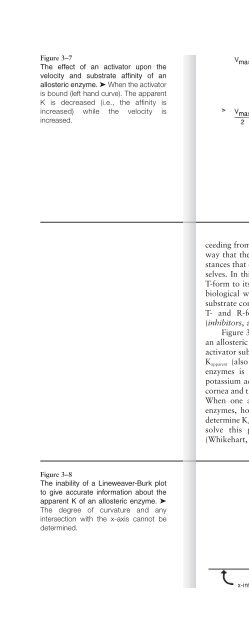- Page 2:
BUTTERWORTH-HEINEMANN An Imprint of
- Page 6:
Acknowledgments I am indebted to th
- Page 10:
disc membrane cytosol N extracellul
- Page 14:
capillary all-trans RETINOL (t) * a
- Page 18:
p53 S p63 p73 G 2 Checkpoints CELL
- Page 22:
Color Plate 9 The Fas receptor mech
- Page 26:
2 • Biochemistry of the Eye Figur
- Page 30:
4 • Biochemistry of the Eye Figur
- Page 34:
6 • Biochemistry of the Eye Figur
- Page 38:
8 • Biochemistry of the Eye press
- Page 42:
10 • Biochemistry of the Eye TABL
- Page 46:
12 • Biochemistry of the Eye TABL
- Page 50:
14 • Biochemistry of the Eye Mayn
- Page 54:
16 • Biochemistry of the Eye Figu
- Page 58:
18 • Biochemistry of the Eye Figu
- Page 62:
20 • Biochemistry of the Eye Figu
- Page 66:
22 • Biochemistry of the Eye Figu
- Page 70:
24 • Biochemistry of the Eye Figu
- Page 74:
26 • Biochemistry of the Eye Figu
- Page 78:
28 • Biochemistry of the Eye proc
- Page 82:
30 • Biochemistry of the Eye TABL
- Page 86:
32 • Biochemistry of the Eye Figu
- Page 90:
34 • Biochemistry of the Eye OH 3
- Page 94: 36 • Biochemistry of the Eye Figu
- Page 98: 38 • Biochemistry of the Eye Figu
- Page 102: 40 • Biochemistry of the Eye Figu
- Page 106: 42 • Biochemistry of the Eye stru
- Page 110: 44 • Biochemistry of the Eye TABL
- Page 114: 46 • Biochemistry of the Eye Figu
- Page 118: 48 • Biochemistry of the Eye Figu
- Page 122: 50 • Biochemistry of the Eye Figu
- Page 126: 52 • Biochemistry of the Eye Berb
- Page 130: 54 • Biochemistry of the Eye Seba
- Page 134: 56 • Biochemistry of the Eye Figu
- Page 138: 58 • Biochemistry of the Eye Figu
- Page 142: 60 • Biochemistry of the Eye Figu
- Page 148: Figure 3-10 Lineweaver-Burk plots f
- Page 152: Figure 3-13 Cut-away diagram of a G
- Page 156: Figure 3-16 Molecular mechanism of
- Page 160: Enzymes • 69 The corneal stroma i
- Page 164: Enzymes • 71 ocular, make use of
- Page 168: TABLE 3-1 ➤ Enzymes • 73 SOME C
- Page 172: Figure 3-24 Gel density pattern of
- Page 176: Figure 3-25 Diagram of aldose reduc
- Page 180: Enzymes • 79 fibrinlike repeats,
- Page 184: Enzymes • 81 breaks structurally,
- Page 188: Enzymes • 83 Kinoshita J: Mechani
- Page 192: C H A P T E R 4 Figure 4-1 Two exam
- Page 196:
Figure 4-4 A common laboratory proc
- Page 200:
Figure 4-7 Partial structure and bo
- Page 204:
Actin-Myosin** (complex of two musc
- Page 208:
Figure 4-11 Diagrammed outline of c
- Page 212:
energetically primes the molecule f
- Page 216:
Figure 4-17 Typical cross-sectional
- Page 220:
Figure 4-19 The Krebs cycle. ➤ Th
- Page 224:
Figure 4-23 The glycerol phosphate
- Page 228:
occurs from the activity of a “de
- Page 232:
Figure 4-26 Gluconeogenesis. ➤ Th
- Page 236:
Carbohydrates • 107 total yield =
- Page 240:
Problems of Carbohydrate Transport
- Page 244:
Figure 4-28 A molecular diagram of
- Page 248:
Figure 4-32 Diagram of islet cells
- Page 252:
Figure 4-34 Glycation reaction. ➤
- Page 256:
Figure 4-35 The polyol pathway. ➤
- Page 260:
ET-1 E-M pathway glucose G3P + DHP
- Page 264:
Figure 4-39 Cross-section of the co
- Page 268:
OCULAR EFFECTS OF GALACTOSEMIA Zonu
- Page 272:
Figure 4-43 Repeating units of the
- Page 276:
Carbohydrates • 127 unknown, but
- Page 280:
Carbohydrates • 129 what type of
- Page 284:
Carbohydrates • 131 Mizutani Y, e
- Page 288:
C H A P T E R 5 Lipids The terms li
- Page 292:
TABLE 5-1 ➤ PARTIAL LIST OF FATTY
- Page 296:
Lipids • 137 Figure 5-4 Phospholi
- Page 300:
Figure 5-6 Two typical isoprenoids.
- Page 304:
Figure 5-10 Sialic acid or N-acetyl
- Page 308:
Figure 5-14 An example of a micelle
- Page 312:
Figure 5-15 The arrangement of the
- Page 316:
Figure 5-17 Layers of the precornea
- Page 322:
150 • Biochemistry of the Eye Fig
- Page 326:
152 • Biochemistry of the Eye Fig
- Page 330:
154 • Biochemistry of the Eye TAB
- Page 334:
156 • Biochemistry of the Eye Dav
- Page 340:
C H A P T E R 6 Hormones The comple
- Page 344:
Figure 6-2 General scheme of hormon
- Page 348:
PEPTIDE, PROTEIN, AND AMINO ACID DE
- Page 352:
STEROID HORMONES1 TABLE 6-2 ➤ Fig
- Page 356:
TABLE 6-3 ➤ SECOND MESSENGER (INT
- Page 360:
Figure 6-7 A cascade mechanism. ➤
- Page 364:
=O R1-C R2-C =O PIP 2 OCH2 OCH CH2O
- Page 368:
INNER SEGMENT OUTER SEGMENT # γ−
- Page 372:
Figure 6-11 Overall diagram of visu
- Page 376:
ROS DISK MEMBRANE (proposed) 3 1 RK
- Page 380:
Figure 6-14 Plasma membrane, hormon
- Page 384:
Figure 6-17 Cross section of kidney
- Page 388:
Figure 6-18 The formation of prosta
- Page 392:
Hormones • 185 to the existence o
- Page 396:
References Hormones • 187 Abdel-L
- Page 400:
Hormones • 189 Urban RC, Cottier
- Page 406:
192 • Biochemistry of the Eye Fig
- Page 410:
194 • Biochemistry of the Eye Fig
- Page 414:
196 • Biochemistry of the Eye Fig
- Page 418:
198 • Biochemistry of the Eye Fig
- Page 422:
200 • Biochemistry of the Eye Fig
- Page 426:
202 • Biochemistry of the Eye Fig
- Page 430:
204 • Biochemistry of the Eye Fig
- Page 434:
206 • Biochemistry of the Eye 40S
- Page 438:
208 • Biochemistry of the Eye 3'
- Page 442:
210 • Biochemistry of the Eye Fig
- Page 446:
212 • Biochemistry of the Eye Fig
- Page 450:
214 • Biochemistry of the Eye p53
- Page 454:
216 • Biochemistry of the Eye The
- Page 458:
218 • Biochemistry of the Eye The
- Page 462:
220 • Biochemistry of the Eye TAB
- Page 466:
222 • Biochemistry of the Eye Fig
- Page 470:
224 • Biochemistry of the Eye Glu
- Page 474:
226 • Biochemistry of the Eye cry
- Page 478:
228 • Biochemistry of the Eye Har
- Page 484:
C H A P T E R 8 Ocular Neurochemist
- Page 488:
Figure 8-2 The differences between
- Page 492:
Figure 8-5 The molecular structures
- Page 496:
Figure 8-8 The receptor protein for
- Page 500:
plasma membrane portion of the prot
- Page 504:
Figure 8-13 Triad synapse found on
- Page 508:
Ocular Neurochemistry • 243 shoul
- Page 512:
Figure 8-17 Principal cells and syn
- Page 516:
Ocular Neurochemistry • 247 There
- Page 520:
C H A P T E R 9 Ocular Immunochemis
- Page 524:
Figure 9-2 The variable domain of a
- Page 528:
Figure 9-4 The large IgM molecule.
- Page 532:
Figure 9-6 The development of plasm
- Page 536:
TABLE 9-3 ➤ (1) tears collected w
- Page 540:
Figure 9-8 The initial reactions of
- Page 544:
Figure 9-11 Peptide binding complex
- Page 548:
Figure 9-14 Diagram of the chemotac
- Page 552:
Figure 9-17 Formation of free radic
- Page 556:
Ocular Immunochemistry • 267 unab
- Page 560:
Ocular Immunochemistry • 269 McBr
- Page 566:
272 • Biochemistry of the Eye Fig
- Page 570:
274 • Biochemistry of the Eye Fig
- Page 574:
276 • Biochemistry of the Eye Fig
- Page 578:
278 • Biochemistry of the Eye Exp
- Page 582:
280 • Biochemistry of the Eye mec
- Page 586:
282 • Biochemistry of the Eye Spa
- Page 590:
284 • Biochemistry of the Eye Agr
- Page 594:
286 • Biochemistry of the Eye Can
- Page 598:
288 • Biochemistry of the Eye Cor
- Page 602:
290 • Biochemistry of the Eye End
- Page 606:
292 • Biochemistry of the Eye Gly
- Page 610:
294 • Biochemistry of the Eye Imm
- Page 614:
296 • Biochemistry of the Eye Met
- Page 618:
298 • Biochemistry of the Eye dur
- Page 622:
300 • Biochemistry of the Eye Pro
- Page 626:
302 • Biochemistry of the Eye Shi
- Page 630:
304 • Biochemistry of the Eye Uns
- Page 634:
306 Answers to Problems Chapter 1 1
- Page 638:
308 • Biochemistry of the Eye 5.
- Page 642:
310 • Biochemistry of the Eye 3.
- Page 646:
312 • Biochemistry of the Eye the
- Page 650:
314 • Biochemistry of the Eye Car
- Page 654:
316 • Biochemistry of the Eye H H
- Page 658:
318 • Biochemistry of the Eye Pro





